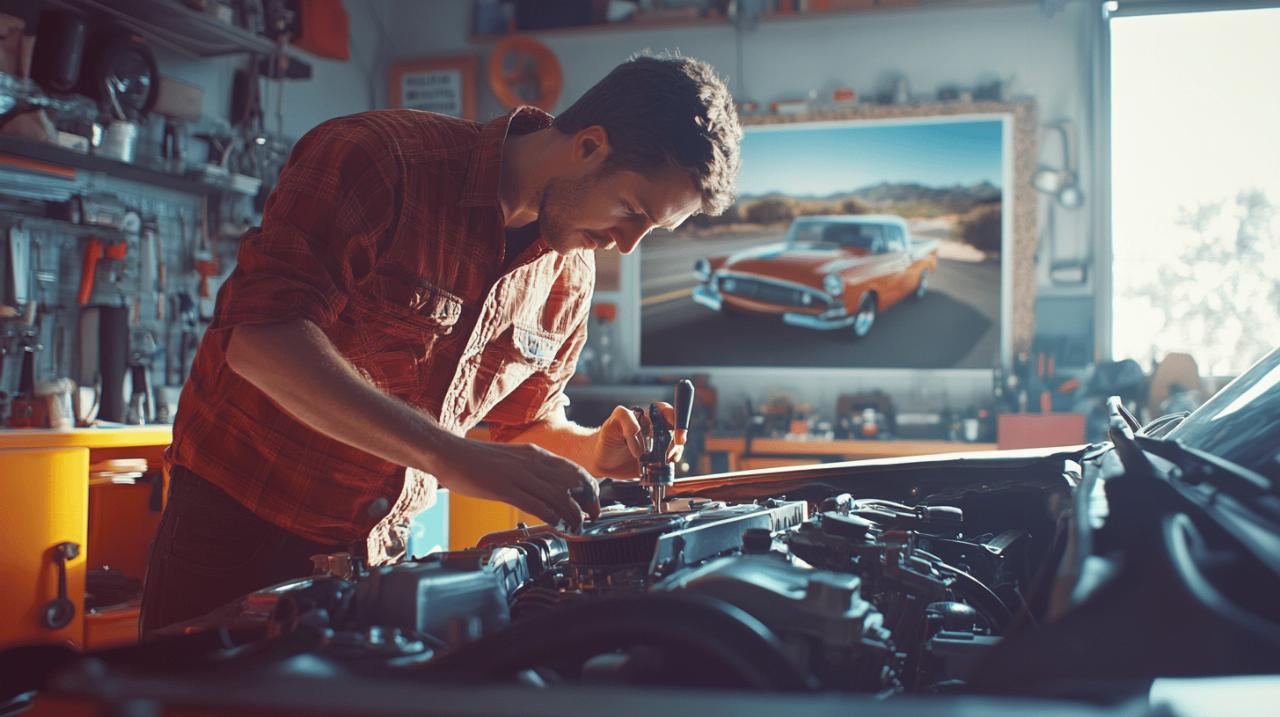How to Ensure Safe Travel with Your Car: The Ultimate Pre-Journey Inspection Checklist

Embarking on a journey by car requires thorough preparation to ensure a safe and stress-free experience. Whether you’re planning a weekend getaway or a cross-country adventure, your vehicle’s condition plays a crucial role in your travel safety. This comprehensive guide will help you prepare your car for any journey, minimising the risk of breakdowns and maximising your peace of mind.
Vehicle Maintenance Essentials
Proper maintenance is the cornerstone of vehicle safety and reliability. Auto Service Gall professionals recommend establishing a regular maintenance schedule that aligns with your vehicle manufacturer’s guidelines. This proactive approach helps identify potential issues before they become serious problems on the road.
Regular Servicing Schedule
Your car requires consistent care to perform optimally. Experts suggest scheduling comprehensive inspections at least once a month if you drive frequently. These regular check-ups should include examining fluid levels, tyre condition, and essential mechanical components. Many motorists overlook the importance of consistent maintenance, but it significantly reduces the likelihood of unexpected breakdowns during your travels.
Critical Safety Checks
Before any long journey, perform a thorough inspection of your vehicle’s critical safety features. This includes checking your braking system by testing the pedal feel and ensuring the vehicle stops promptly without pulling to either side. Examine all lights including headlights, indicators, brake lights, and fog lights. The electrical system deserves attention too, so verify that power windows, air conditioning, and heating systems function correctly. These checks form the foundation of a safe journey.
Journey Planning and Preparation
A well-planned journey can save you from unnecessary stress and potential hazards on the road. Taking time to prepare your route and anticipate possible challenges is as important as ensuring your vehicle is in good condition.
Route Planning Strategies
Planning your journey carefully helps avoid unexpected complications. Use up-to-date navigation tools while keeping traditional road maps as backup options. Consider factors such as distance, driving conditions, and potential rest stops when mapping your route. Knowing where you can refuel is particularly important for longer journeys through unfamiliar territories. Take time to research parking options at your destination to avoid last-minute scrambling.
Traffic Updates and Diversions
Stay informed about road conditions using the National Highways tool to check for planned roadworks or closures that might affect your journey. Weather conditions can significantly impact driving safety, so monitor forecasts before departure and throughout your trip. Being aware of potential diversions allows you to adjust your plans accordingly, saving time and reducing stress during your journey.
Emergency Preparedness
Even with meticulous planning and vehicle maintenance, emergencies can occur. Being prepared for unexpected situations ensures you can handle problems effectively and safely.
Essential Items for Your Emergency Kit
A comprehensive emergency kit is invaluable during unexpected situations. Include a warning triangle and high-visibility vest for each passenger to ensure visibility if you need to stop on the roadside. A well-stocked first-aid kit can address minor injuries until professional help arrives. Other essential items include jumper cables, a torch with spare batteries, an emergency foil blanket, and sufficient water. Some motorists also carry a small fire extinguisher as an additional safety measure.
When and How to Use Emergency Equipment
Understanding how to use emergency equipment correctly is as important as having it available. Familiarise yourself with the location and operation of your vehicle’s jack and wheel brace if you have a spare tyre. If your vehicle uses a tyre repair kit instead, practice using it before an actual emergency occurs. Know how to position warning triangles at appropriate distances from your vehicle to alert approaching traffic. These preparations can make a significant difference in managing roadside emergencies efficiently.

Driver Wellbeing and Awareness
Your physical and mental condition significantly impacts driving safety. Maintaining alertness and managing fatigue are essential aspects of responsible driving, especially during extended journeys.
Rest Stops and Fatigue Management
Driver fatigue is a major contributor to road accidents. Experts recommend taking a break of at least 15 minutes every two to three hours during long journeys. Use these stops to stretch your legs, hydrate, and refresh your mind. Planning your rest stops in advance helps maintain a comfortable rhythm during your journey. Avoid driving during hours when you would normally be sleeping, as your alertness naturally decreases during these periods.
Defensive Driving Techniques
Adopting defensive driving practices helps anticipate and avoid potential hazards. Maintain awareness of surrounding vehicles and road conditions at all times. Keep a safe distance from the vehicle ahead to allow sufficient reaction time if they stop suddenly. Remain mindful of other road users, including cyclists and pedestrians, particularly in urban or residential areas. These techniques create layers of safety that protect you and your passengers throughout your journey.
Luggage and Passenger Safety
How you load your vehicle affects both safety and comfort during your journey. Proper weight distribution and secure storage prevent items from becoming hazards in emergency situations.
Proper Loading and Weight Distribution
When packing your vehicle, place heavier items in the centre and back of the boot to maintain optimal weight distribution and vehicle balance. Avoid overloading your car beyond its designed capacity, as this affects handling and braking performance. If using a roof box for additional storage, reserve it for lighter items such as blankets or soft luggage. Remember to adjust your tyre pressure according to the increased load to maintain proper contact with the road surface.
Securing Items to Prevent Hazards
Loose items can become dangerous projectiles during sudden stops or collisions. Secure all luggage and equipment properly to prevent them from shifting during travel. Avoid stacking items above the headrest level in the boot, as this obstructs rear visibility and creates potential hazards. Removing unnecessary items from the passenger compartment reduces distractions and keeps the driving environment tidy. These simple measures significantly enhance safety during your journey.
Tyre Management
Your tyres are the only point of contact between your vehicle and the road, making their condition crucial for safe travel. Regular inspection and maintenance of tyres prevent many common roadside emergencies.
Pressure Checks and Adjustments
Correct tyre pressure is essential for optimal handling, fuel efficiency, and tyre longevity. Check pressures when tyres are cold, ideally before starting your journey. Consult your vehicle handbook or the information label typically found on the driver’s door frame for recommended pressures. Remember that heavily loaded vehicles may require higher tyre pressures, so adjust accordingly when carrying passengers and luggage. After long journeys, allow tyres to cool for a couple of hours before checking pressures again.
Tread Depth and Condition Assessment
The legal minimum tread depth in the UK is 1.6mm across the central three-quarters of the tyre width. A simple way to check this is using a 20 pence coin inserted into the tread groove. If the outer border of the coin remains visible, your tread may be insufficient. Examine tyres for signs of damage such as cracks, bulges, or embedded objects. Driving with tyres below the legal tread depth can result in fines of up to £2500 and three penalty points per tyre, not to mention the increased safety risks.
Breakdown Cover and Assistance
Despite thorough preparation, breakdowns can still occur. Having appropriate assistance coverage provides peace of mind and practical help when you need it most.
Choosing the Right Coverage Level
Breakdown cover offers valuable protection during journeys, particularly long ones or those to remote areas. When selecting coverage, consider factors such as journey frequency, typical distances travelled, and vehicle age. More comprehensive policies may include home start assistance, onward travel arrangements, and European coverage if relevant. The small investment in appropriate breakdown cover can save substantial time, money, and stress if your vehicle experiences problems during your journey.
What to Do When Breakdown Occurs
If your vehicle breaks down, safety should be your primary concern. Move to a safe location if possible, such as a hard shoulder or lay-by. Turn on hazard lights immediately and position warning triangles to alert other drivers. Ensure all passengers exit the vehicle on the safe side, away from traffic, and wait behind safety barriers if available. Contact your breakdown service provider with precise details of your location and nature of the problem. Remaining calm and following these procedures helps manage the situation effectively until assistance arrives.
Communication and Travel Updates
Staying connected during your journey enhances safety and allows for adjustments to changing conditions. Effective communication strategies keep both you and concerned parties informed throughout your travels.
Sharing Your Itinerary Safely
Before departing, share your planned route and estimated arrival time with someone trustworthy. This ensures someone knows where you should be and when, potentially expediting assistance if needed. Avoid publicly posting travel plans on social media, which could indicate your home is unoccupied. Instead, use private messaging or direct calls to share necessary information with specific individuals who need to know your whereabouts.
Keeping Connected During Long Journeys
Maintain communication capabilities throughout your journey with fully charged mobile devices and car chargers. Consider setting your phone to do not disturb mode while driving to avoid distractions, enabling automatic responses to incoming messages. Update your contacts about significant delays or route changes, but always pull over safely before using communication devices. These practices keep you connected without compromising your attention to the road.
Legal Compliance on the Road
Adhering to legal requirements is a fundamental aspect of responsible driving. Ensuring your vehicle and documentation comply with regulations prevents unnecessary complications during your journey.
Speed Limits and Traffic Regulations
Observe posted speed limits and traffic regulations throughout your journey. Different road types have specific limits, and temporary restrictions may apply in construction zones or due to weather conditions. Familiarise yourself with any unique regulations at your destination, particularly if travelling internationally. Compliance with these rules not only avoids penalties but significantly contributes to overall road safety for all users.
Documentation and Legal Requirements
Carry all necessary documentation including your driving licence, vehicle registration, insurance details, and valid MOT certificate. If travelling abroad, research additional requirements such as International Driving Permits or specific equipment mandated by local laws. Ensure your vehicle meets all legal standards, including properly functioning lights, adequate tyre tread, and emission controls. These preparations prevent potential legal issues that could disrupt your journey.
Post-Journey Vehicle Checks
The care you provide your vehicle after a journey contributes significantly to its longevity and reliability for future travels. Post-trip inspections identify any issues that developed during your travels.
Identifying Issues After Travel
After completing your journey, perform a thorough visual inspection of your vehicle to identify any new damage or developing issues. Check for fluid leaks underneath the vehicle and unusual noises that may have developed. If you noticed any warning lights or unusual behaviour during your trip, address these promptly rather than waiting for your next scheduled service. This proactive approach prevents minor issues from escalating into major problems.
Maintaining Your Car Between Trips
Regular maintenance between journeys keeps your vehicle in optimal condition for future travels. Clean both the exterior and interior thoroughly, removing road grime that can cause corrosion over time. Check fluid levels after the engine has cooled completely, typically eight hours after use. Remove all rubbish and unnecessary items from the vehicle. These simple practices maintain your car’s condition and ensure it remains ready for your next adventure on the road.












